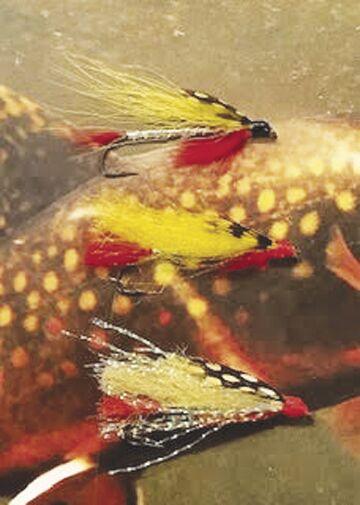July has been an exceptional month for trout fishing in the Mount Washington Valley. Rain and cooler temperatures have kept water levels prime. Stream and pond water temperatures have been very trout-friendly.
With the excellent fishing conditions, there have been many anglers in pursuit of trout. At this time of the year, a trout has seen every pheasant tail nymph, partridge and orange soft hackle and yellow sally dry fly. Watching a 15-inch trout chase and look at your fly offering and then turning away can get frustrating very quickly.
This happens each trout fishing season. Trout get educated during a fishing season. When the trout start to do what I call the “look and laugh,” it signals time to pull out and old fly tying book and search for a pattern that has fallen out of favor. This season, I grabbed Dick Surrette’s “Fly Tyer Pattern Bible” and began perusing the trout fly section of the book.
Turning each page, nothing was really saying, “I’m the one!” On the very last page of the trout fly pattern section, the Yellow Venison, a pattern tied by Fred Andrews, jumped up and said, “Pick me!”
The Yellow Venison is a simple bucktail streamer. A red hackle tail and throat, silver tinsel with oval tinsel ribbing body, yellow bucktail wing with a guinea fowl feather topping. The fly is tied with black monocord thread on a size 2 long shank streamer hook. A perfect hook choice for Spring trout fishing.
The fly looked like a great attractor pattern, but the materials were old school. Off to the tying bench to see if the fly could be adapted for Summer trout fishing and incorporate some modern tying materials.
The first attempt used red hank in place of red hackle, holographic silver tinsel for the body and ice wing material for the wing. The guinea fowl topping remained unchanged. This fly was tied with hot red thread on a size 8 Mustad 9575 hook. While the fly looked fishy, the wing was too yellow. Back to the drawing board.
This attempt used red fluro fibre, pearl tinsel, yellow nylon mixed with krystal flash. All other components remained the same. This fly was now screaming, “Fish me!” Off to the river.
To run a true test, all three variations of the Yellow Venison made the trip to the river. Each fly would be fished for 20 minutes. Equipment used was the Scott Flex nine foot four weight with an Orvis Hydros Depth Charge 150 grain line and a 7½ foot 4x leader.
The pool in the river was deep and it took a count of twenty to get the fly to the right depth. The original Yellow Venison received several “bumps,” but no fish were brought to hand during the flies twenty minute trial. The Ice Wing version of the Yellow Vension was next.
Casting the fly to the same spots in the pool and repeating the count down, after two strips of the fly line, a trout was fast to the line. The trout ran up and down the pool and when brought to hand was a fine 14-inch female brook trout. That was the only trout that the Ice Wing produced.
Time to try the final version of the Yellow Venison. Repeated the same casting regimen. There was one big change. Each cast produced a fine brook trout with the largest being 16 inches and over 2 pounds.
The trout loved the modern serving of Yellow Venison and the fly earned a spot in the brook trout fly box.
Try your favorite flies and lures in different hook sizes because there are times when size matters.
Steve Angers, a native to the Conway area, is the author of the book “Fly Fishing New Hampshire’s Secret Waters” and operates the North Country Angler.
Credit: Source link






























